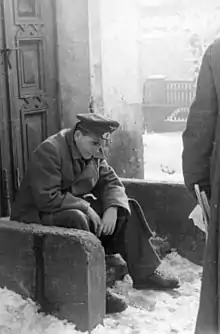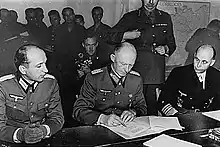尼禄法令
尼禄法令(德語:),亦称焦土法令,正式名称为《帝国领土拆除法令》(德語:),是1945年3月19日由阿道夫·希特勒下达,納粹德國国防军最高统帅部颁布的一项法令。该法令旨在下令摧毁纳粹德国的基础设施,以防止盟军在深入德国境内时使用这些设施。其大致内容为“命令撤退的同时对占领地区的工业、文化、经济等进行破坏…”。随后被称为尼禄法令,以罗马皇帝尼禄的名字命名,根据一个虚构的故事,他在公元64年设意制造了罗马城的大火[1]。战中阿尔伯特·施佩尔刻意不遵守该法令。
Background
By the beginning of 1945, the German situation was desperate.[2] Most of the conquered territories had been liberated or recaptured, the Ardennes Offensive had failed, and Allied armies were advancing on Germany proper from both the East and the West. However, Hitler was not willing to accept the terms of unconditional surrender, and considered this as repeating the same shame as Versailles.[2] Moreover, according to some around him, Hitler came to view the German people as having failed him, unworthy of their great mission in history and thus deserving to die alongside his regime.[3]

This was not the first time Hitler had tried to destroy infrastructure before it could be taken. Shortly before the Liberation of Paris, Hitler ordered explosives to be placed around important landmarks, such as the Eiffel Tower, and key transportation hubs. If the Allies came near the city, the military governor, General Dietrich von Choltitz was to detonate these bombs, leaving Paris "lying in complete debris."[4] Von Choltitz, however, did not carry out the order and surrendered to the Allies, later alleging that this was the moment he realized that "Hitler was insane." Similarly, Hitler had issued orders to enact a scorched earth policy upon the Netherlands in late 1944, when it became obvious that the Allies were about to retake the country, but Arthur Seyss-Inquart, the Reichskommissar in charge of the Netherlands during its occupation, was able to greatly limit the scope to which the order was executed.[5]
The Decree

Its most pertinent section reads as follows:
It is a mistake to think that transport and communication facilities, industrial establishments and supply depots, which have not been destroyed, or have only been temporarily put out of action, can be used again for our own ends when the lost territory has been recovered. The enemy will leave us nothing but scorched earth when he withdraws, without paying the slightest regard to the population. I therefore order:
1) All military transport and communication facilities, industrial establishments and supply depots, as well as anything else of value within Reich territory, which could in any way be used by the enemy immediately or within the foreseeable future for the prosecution of the war, will be destroyed.[6]
Actions

The decree was in vain. The responsibility for carrying it out fell to Albert Speer, Hitler's Minister of Armaments and War Production. According to him, Speer was appalled by the order and lost faith in the dictator. Just as von Choltitz had several months earlier, Speer deliberately failed to carry out the order. Upon receiving it, he requested to be given exclusive power to implement the plan, instead using his power to convince the generals and Gauleiters to ignore the order. Hitler remained unaware of this until the very end of the war, when Speer, while visiting Hitler in his Berlin bunker, admitted to him that he deliberately disobeyed.[7] Hitler was angry with his minister, but allowed Speer to leave nonetheless. Hitler committed suicide on 30 April 1945, forty-two days after issuing the order. Shortly afterwards, on 7 May 1945, General Alfred Jodl signed the German military surrender, and on 23 May Speer was arrested on the orders of U.S. General Dwight D. Eisenhower, together with the rest of the provisional German government led by Admiral Karl Dönitz, Hitler's successor as head of state.
参见
- Albert Speer
- Gotthard Heinrici
- Hellmuth Reymann
- Is Paris Burning?
- Morgenthau Plan
- Destruction of Warsaw
- Railroad plough
- Scorched earth
参考文献
- Publius Cornelius Tacitus. . Book 15 [15.16]. [27 October 2021]. (原始内容存档于14 April 2009).
Nero at this time was at Antium, and did not return to Rome until the fire approached his house
- . Wired. 19 March 2007 [2022-10-17]. (原始内容存档于2014-03-13). 参数
|magazine=与模板{{cite news}}不匹配(建议改用{{cite magazine}}或|newspaper=) (帮助) - . Government Printing Office. [2022-10-17]. ISBN 978-0-16-089940-9. (原始内容存档于2022-10-17) (英语).
- . Amazon.de. [25 August 2008]. (原始内容存档于2013-01-05).
- . The Avalon Project. [2022-10-17]. (原始内容存档于2016-04-21).
- Hugh R. Trevor Roper (ed). Blitzkrieg to Defeat: Hitler's War Directives 1939–1945 (NY: Holt Rinehart and Winston, 1971) pp. 206–207
- Hamsher (Wiliam), Albert Speer / Victim of Nuremberg ?, Londres, Frewin, 1970; Schmidt (Matthias), Albert Speer / Das Ende eines Mythos, Munich, Scherz, 1982